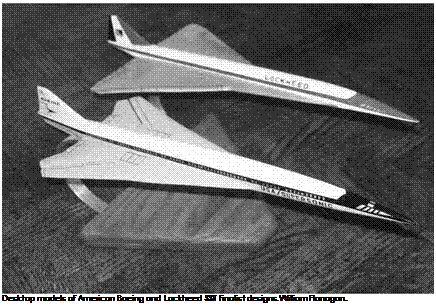The American SST Program: Competition, Selection, and Demise
NASA participated extensively in plans to develop an American SST. President Kennedy had committed the U. S. Government to contribute funding for 7 5 percent of the aircraft’s development cost, with a $1-billion upper limit. Industry would contribute the rest of the cost, with the Government money to be repaid via royalty payments as aircraft were sold. This Government backing was a response to the 1962 announcement of a joint government-backed program between France (Sud Aviation) and England (British Aircraft Corporation) companies to develop a Mach 2.2, 100-passenger transport, which emerged as the graceful Concorde. The FAA, NASA, and the Department of Defense would manage the American program and select a final contractor to make the SST a reality.[1092] The competition aspect of the program gained even more of a Cold War aspect when the Soviet Union announced in June 1965 that it also was developing a Mach 2.2 SST, which would fly in 1968. The United States was still deciding on a contractor and design to be given the go-ahead.
 |
|
The finalist contractors selected in May 1964 were Lockheed and Boeing, after rival Douglas and NAA designs (the latter based on B-70 technology) were eliminated. Although the initial submissions had a speed requirement of Mach 2.2+ with 160 passengers, the selected initial designs were a double delta Lockheed Model 2000 Mach 3 aircraft and a Boeing Model 733 Mach 2.7 variable sweep aircraft reminiscent of the NASA SCAT 16 design. Both finalist contractors had done analyses of the NASA SCAT designs in 1963. They had reached the conclusion that at Mach 2.2, the range specification could not be achieved, so they opted for the higher Mach cruises. FAA Administrator Najeeb Halaby had favored the higher cruise speed with larger capacity to preempt the Concorde in the international airliner marketplace. General Electric and Pratt & Whitney were the engine contractors chosen to develop engines for the SST. Both had developed 30,000-pound thrust engines for supersonic cruise airplanes (GE J93 for the XB-70 and Pratt & Whitney J58 for the A-12/SR-71), but the SST would require four 60,000-pound thrust engines.
The selection was announced on the last day of 1966. The Lockheed configuration had remained relatively unchanged, while the Boeing fuselage had been made longer and the engine position had shifted from under the wing to under the tail. Even the name had been changed, to
Boeing 2707. Both contractors built impressive full-scale mockups that were as much publicity props as engineering tools. (Unfortunately, the impressive mockups would prove to be the only airplanes built.) With fuselage lengths around 300 feet to accommodate up to 300 passengers and the fuel for ranges of over 3,000 miles, the mockups represented a new dawn in civil aviation. But the Boeing design and the Pratt & Whitney engine were chosen as the United States’ entry in the supersonic airliner derby. (Details of the Boeing design showed that the variable sweep wing was unachievable because of weight and complexity; the Boeing design had 59 control surfaces, versus the Lockheed design’s 16). Eventually, the Boeing design evolved to a fixed double delta with a small horizontal tail and four underwing engine nacelles with axisym- metric inlets. American flag carriers placed $100,000 deposits to reserve delivery positions on the production line with an order book of 120 aircraft by 1969, and work began on the first prototype.[1093]










